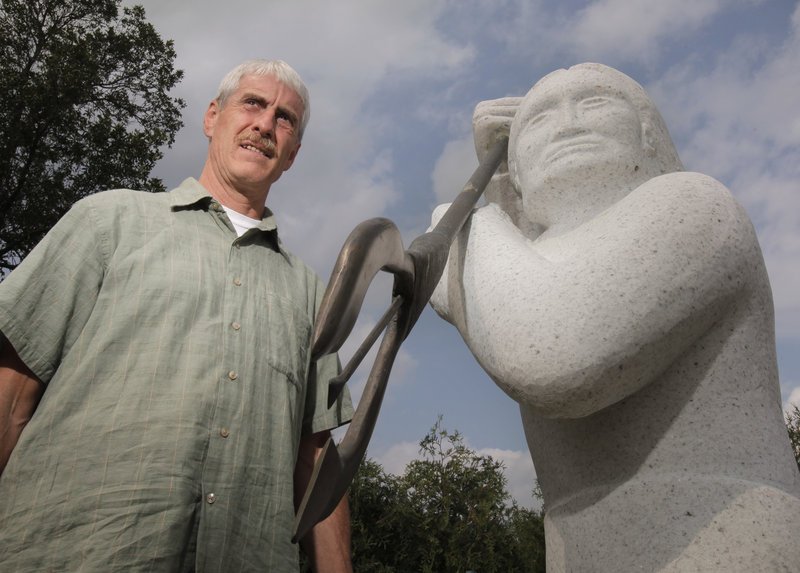INDIAN ISLAND – In 1835, when the new dam at Veazie was closed in the winter, blocking all fish passage, the Penobscot Indians protested that the dam would destroy the annual runs of salmon and other sea-run fish.
Their complaints went unheeded, even when thousands of shad and alewives the following spring lingered about the new dam and died there, filling the air with a powerful stench.
The sea-run fish that once journeyed up the Penobscot River by the millions to spawn have dwindled to the hundreds. It’s been more than 25 years since the Penobscot Indian Nation formally harvested a salmon for a ceremony.
But tribal members are now looking forward to the day when they will harvest salmon once again, thanks to the 2004 multi-party settlement that will make way for the removal of two dams downstream from Indian Island and improved fish passage on a third dam.
For the Penobscot Indians, the anticipated return of sea-run fish is more than just an important victory for an environmental cause. It will allow tribe members to embrace their cultural heritage, said John Banks, director of the Penobscot Nation Department of Natural Resources.
Standing on a bluff overlooking the river, he recounted the tribe’s decades-long battle to improve fish passage in the river, first blocking the construction of a hydropower dam at Basin Mills and then serving as a key player in negotiations that led to the settlement.
The hard work is done, he said, and now the tribe can look to the future with hope.
“We are waiting for the fish to come back,” he said.
The Penobscot Nation has about 2,200 members, approximately 400 of whom live on Indian Island, one of 200 reservation islands in the Penobscot watershed.
The Penobscot Nation is a federally recognized sovereign Indian tribe. The tribe’s legal status was a crucial factor in the settlement agreement because it gave the tribe leverage during the federal license renewal process for the hydroelectric dams in the watershed.
Collaborating with environmental groups, including the Atlantic Salmon Federation, the tribe argued that the federal government is required to ensure proper management and protection of tribal natural resources, such as the right to harvest fish within the waters of their jurisdiction.
The tribe’s arguments — contested by then-dam owner PPL Corp. — threatened the company’s ability to continue winning licenses from the federal government to produce power on the river.
Banks gives credit to Scott Hall, who was operating the Maine dams for PPL Corp., for taking the initiative to seek a multiparty agreement for the entire Penobscot River basin.
In December 1999, Banks said, a critical meeting took place in a tribal administrative building, a log building on Indian Island. Attending were tribal leaders, government officials and representatives of PPL and several environmental groups.
That meeting opened the way for talks that concluded with the 2004 settlement.
Without the agreement, the issue would have been tied up in court for many years with no predictable outcome for either side, Banks said.
“Both sides wanted something more certain,” he said. “We wanted certainty in the future ecological health of the river, and the company wanted some financial security to be able to maintain its generation business.”
The Penobscot River Restoration Trust was formed to implement the project. Under an agreement, PPL agreed to sell the three dams to the trust for roughly $25 million. PPL, in return, was allowed to increase power generation at six other dams along the river, offsetting the losses incurred when the Veazie and Great Works dams are no longer in use.
PPL also agreed to install a state-of-the-art fish lift at the Milford Dam, which will become the first dam on the river upstream from the Gulf of Maine once the Veazie and Great Works dams are removed.
Banks said that traditional native beliefs about river ecology are now being supported by researchers involved in the river recovery project.
For instance, salmon are able to climb fish ladders much more successfully than other sea-run fish, such as shad and alewives. Assuring that all sea-run fish are able to swim upriver increases the spawning success of Atlantic salmon, he said. When the river is filled with millions of other fish, he explained, juvenile salmon are less likely to be eaten by predators.
“We have always looked at the river as a living, breathing entity in its own right, and we have attempted to approach its recovery in a holistic way,” he said.
MaineToday Media State House Staff Writer Tom Bell can be contacted at 791-6369 or at:
tbell@mainetoday.com
Send questions/comments to the editors.



Comments are no longer available on this story